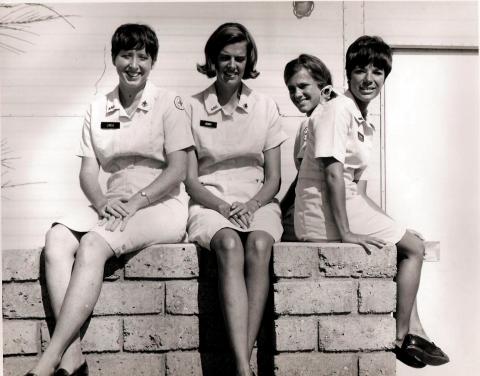Frontlines and Heartlines: A Journey to the Past in THE DONUT DOLLIES

THE DONUT DOLLIES
These notes on Norman Anderson’s The Donut Dollies were written by Samantha Janes, graduate student in UW Madison's Department of Communication Arts. The Donut Dollies will screen at the Cinematheque on Saturday, February 26 at 7 p.m., in conjunction with with University Theatre’s production of Shirley Lauro’s A Piece of My Heart, directed by Baron Kelly, with performances running March 3-11.
By Samantha Janes
During the First World War, the Salvation Army began to recruit female volunteers for various tasks that ranged from nursing to food administration. The “Donut Dollies,” as they were later nicknamed in the Second World War, were born from the work of women who held positions that focused on recreation and food. The idea of bringing a simple, easily distributed dessert from the United States to the frontlines of the war was meant to boost morale and remind the troops of home. This connection to home proved of so much value to the soldiers during their times overseas that when America entered the Second World War, the American Red Cross established the Clubmobile Services that included women serving donuts. This tradition continued throughout the Korean War, but in Vietnam, the Donut Dollies became a much more visible presence to American troops. Even with the long legacy of the Donut Dollies’ connection to the war efforts, their stories are seldom mentioned in the history books covering America’s wars.
Norman Anderson’s 2019 documentary film, The Donut Dollies works to rectify this gap and preserve Donut Dollies’ stories through the lens of his mother Dorset’s enlistment in the program and her journey back to Vietnam forty-six years later. Anderson, a producer, writer, and documentary filmmaker most known for his television work with National Geographic and the Discovery Channel, spent twenty years working on this first feature film. Through his combination of home videos, interviews, and archival footage, Anderson weaves his mother’s story of her time as a Donut Dollie with the memories of other women who served in the program, Vietnam veterans, and current citizens of cities such as Nha Trang and Củ Chi.
While other documentaries such as Patrick and Cheryl Fries’ A Touch of Home: The Vietnam War’s Red Cross Girls (2007) explore the story of the American Red Cross’s Supplemental Recreation Activities Overseas (SRAO) program that made the young, college-educated women into Donut Dollies during the war, Anderson’s film thrives due to his special connection to the preservation of the Donut Dollies legacy. The personal footage of Anderson beginning his research on his mother’s work as a Donut Dollie dates back to 1998 and continues through 2015 when his mother and Mary Bowe, Dorset’s college roommate and another former Donut Dollie, travel back to Vietnam in an attempt to receive closure from their previous experiences while also honoring the memories that they hold dear.
The Donut Dollies does not glamorize the war nor the women’s experiences at different bases across the country. Through interviews, the former Donut Dollies confront their lack of preparation and understanding of the war until their arrival in combat zones. According to Dorset, this lack of knowledge around the war and its impact on the world was exactly what she was seeking clarity on when she signed up for the program. For some women, such as Mary Atkinson, who was in Vietnam from 1967 to 1968, it was a hatred of the war that led her to enlist and “find the scoop” on the reasons behind the protest, draft card burnings, and brewing panic across the country. With mentions of the Tet Offensive and the nation-wide arguments over America’s involvement in the war, many Donut Dollies were clear in their interviews with Anderson that their reason for enlisting in the program was due to the fact that they recognized America’s involvement in the war was not going to stop and that they were best suited to join the war effort as “the morale for the enlisted man.”
This attempt to keep up morale for the soldiers led to many Donut Dollies suffering in silence through their physical, mental, and emotional turmoil during and after their time in the war. Dorset and Mary recall tragic experiences of some of the Donut Dollies, and many Donut Dollies mention they chose to remain silent on their experiences after returning home from Vietnam. Anderson carefully draws out the heartaches of these women while also balancing a focus on the effect of the war on veterans and the people of Vietnam.
As Dorset and Mary journey to Vietnam in 2015, they encounter veterans such as Bob, who serves as their first contact, and others they meet by happenstance during their travels. As the women make their way through the various cities and landmarks they recall from their previous experiences, Anderson utilizes archival footage to demonstrate the changes that occurred over the years following the war. The beauty of Vietnam and its people are never far from the minds of Dorset and Mary, even as they recall the tragedies they faced as a result of the war. Throughout their journey back to Vietnam, the impact of the war on the lives of the Donut Dollies, the veterans, and the citizens of Vietnam is poignantly recognizable through discussions of PTSD, Agent Orange, and emotional heartaches. However, the ability of Dorset and Mary to reflect on their experiences and reconcile with their current lives provides a sense of tentative catharsis that lingers long after the film is over. After twenty years of work and a successful Kickstarter campaign, Anderson’s The Donut Dollies comes to life on screen and ultimately provides the heartfelt histories of an often-forgotten group of women in a way that brings a new perspective to viewing the frontlines of the Vietnam War.
